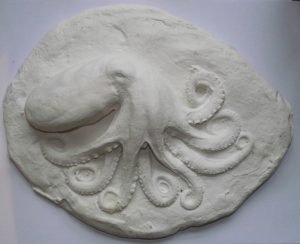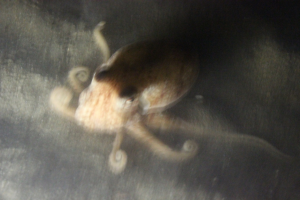Curly The Curled Octopus
How Curly became our logo
We have just produced a new batch of t-shirts, in response to comments from customers, featuring curly the curled octopus.
In effect we have launched the lifeforms brand as a brand; not what we expected to do. Our aspirations were much more unassuming – an environmental message using art. Our popular logo is now available on a T-shirt. A 100% organic cotton Fair Wear certified T-shirt of course!
We call our logo ‘Curly the Octopus’. She came to be when I found a dead octopus after a storm.
Tales of a Taxidermist!
Tell me to get stuffed if you like but it’s true; I was trained as a taxidermist and museum display artist from the age of 16. I never ever saw death as the end but as a new beginning – that’s the bright side of taxidermy folks. My desire to work in museums sprang into life when I was about 7 years old and is the centre of many family stories. I was the boy who brought dead things home. On many occasions the family car would screech to a halt, so I could pick up, or at least identify, a cadaver by the roadside which, all too often for my sister, would then end up in the car with us (sorry Tina!). But, that’s another story and this is about Curly and her kin.
Finding Curly
We moved to coastal Wales about 17 years ago and I visit the beach almost every day. I discovered that night-time beachcombing can be very rewarding because I get to the strandline before the gulls do. One January night in 2016, after a chilly storm, I spotted a white filament protruding from the seaweed and horn-wrack. Glowing in the torchlight, it looked like it might belong to a cephalopod. This was exciting. I moved away the debris like Howard Carter unveiling Tutankhamun and saw ‘wonderful things’… tentacles! It was Curly. Having never found an octopus in Britain before, this was quite exciting. I attempted to revive her in a rock pool but, apart from very slight colour changes there were no signs of life and I presumed her dead.
Another hour in a bubbling bucket of seawater made no further difference and so I disappeared into the basement with her to make a plaster cast. I was gone quite a while. Casting is the taxidermy method of replicating specimens which have soft or bare skin and it produces a perfect facsimile. Hand-made fossils is how I like to think of them. They have the potential to last forever.

Creating Fossils
The result was absolutely beautiful. A beguiling fossil of an almost ‘unfossilizable’ animal. Casting preserves shapes and textures and cuts out the distraction of colour. I get very excited about it and am always looking for unusual textures in nature. We exhibited the cast at a couple of fairs where it became evident that it was not just us that liked it and so we decided to make it our first image for a T-shirt.
It took quite a while to render Curly onto paper, I based the artwork on the cast, photographs of ‘Curly’ and photographs from an exquisite book from the 1960s called Life in the Sea. I decided to create a stippled line art image first because stippling, like casting, prioritises texture and form rather than colour.
We were working on other images to launch Lifeforms Art at the time and we knew we needed a logo but we all looked at Curly on the T-shirt and said… “That’s our logo.”
Call me Curly!
I was also once known as ‘Curly’ before I moulted into what I like to think is a silverback! If you are now thinking of a curly gorilla you’ve gone too far. One of the early stages of decomposition in mammals and birds is when the epidermis (outer skin) comes loose and the fur or feathers ‘slip’ away from the skin in a process known as ‘slipping’. So perhaps the joke, old taxidermists never die, they just get stuffed should be … they just slip away. Anyways, my profile is more octopus and gorilla but in my heyday (as in, hair like hay)…
“Hasn’t he got lovely hair.” Old ladies used to observe when I was out with my Grandma. It wasn’t a question. “You’ve got lovely curls,” they’d say, “can I touch it?” And they would, so that wasn’t really a question either. Curly was also the nickname of General Custer and his nemesis Crazy Horse where tribal people stood up against their oppressors in the battle of the Little Big Horn… two Curlys fighting it out… with lovely hair; but I digress.
Curly the octopus
Our Curly (now known as Curly the 1st) is a Curled or lesser octopus (Eledone cirrhosa), a species much more common in British waters than the better-known common octopus which increase in numbers south of the English Channel and into the Mediterranean.
Since finding Curly we have found many more octopuses stranded on the beach at night, some dead, but many alive which we have returned to the sea after weighing, measuring and photographing them. Quite undignified out on the beach, they are mostly half-grown animals and seem to struggle when the sea temperature suddenly drops. In a lethargic state they are caught by the waves and cannot resist being washed ashore even in fairly mild wave action. We wait until low tide, keeping them in well aerated buckets and throw them, gently, out beyond the waves or release them in a very sheltered rock-pool if the sea is rough. Their chances are not great, but we feel a kind of affinity with them, they seem to look into our eyes directly and touch a sympathetic nerve.
Meanwhile, out at sea, trawlers are processing thousands a day without a thought for how our little friends feel about it.
Octopus Behaviour
Octopuses are very intelligent as you probably know. They live from two to five years (usually about 3) but have impressive learning and problem-solving capabilities. This is perhaps best summed up by octopus’ researcher, Mark Rehling who stated; “puzzles designed for primates were just too simplistic… if the octopus was interested, a solution was sure to follow.” The research is still going on, but octopuses can taste or smell prey, and danger with their suckers and are formidable predators. They quickly despatch crabs and lobsters by biting the eye and releasing toxic saliva which paralyses their powerful sharp-clawed prey which in a normal state could crush or tear-off the octopus’s arms
One interesting bit of behaviour we have seen but not found recorded anywhere else is their ability to sink into sandy substrates. When placed in sandy tidal pools to recover from the anoxia, two out of about eight animals have begun a rhythmic action of huffing and puffing and wriggling. This results in them sinking into the sand until only the eyes and the tips of two tentacles are showing. The action and final position seem quite ritualised.
I have followed common cuttlefish and little Atlantic cuttlefish underwater and seen them sink into the sand but never observed it in common octopus (in the Mediterranean) which tend to create a lair in debris or beneath a rock. It may be a common occurrence, but Jacques Cousteau never mentioned it and I have not seen film of it anywhere else.




Although three years, the life span of an octopus, have past. I still delight in looking at the fossil of Curly the 1st which, along with our logo, will hopefully carry on raising awareness of marine life and environmental issues for many years.


